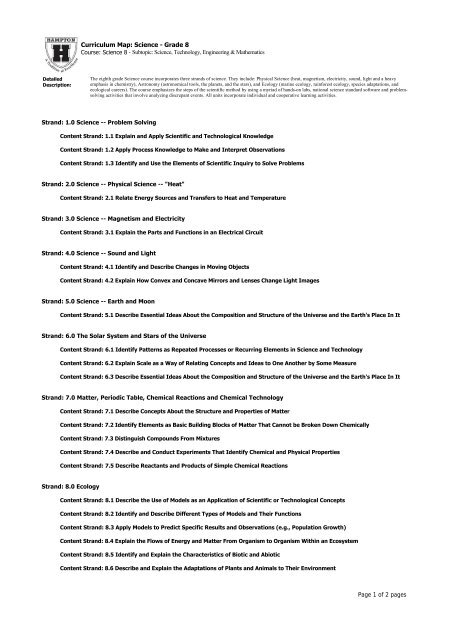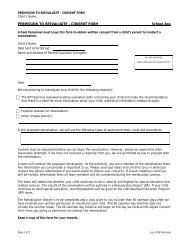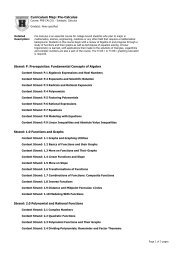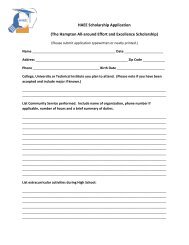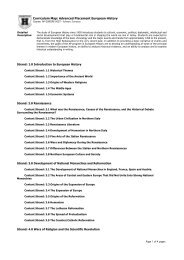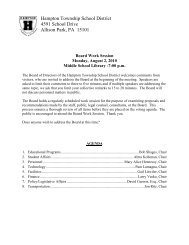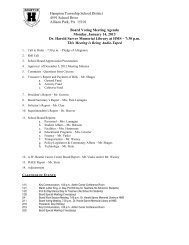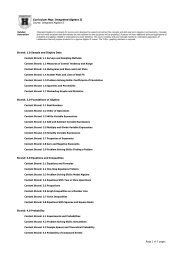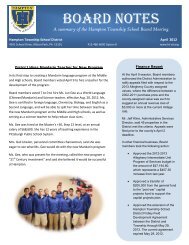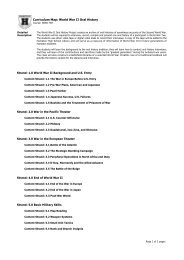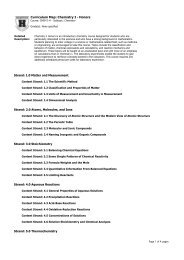Curriculum Map: Science Grade 8 Page 1 of 2 pages
Curriculum Map: Science Grade 8 Page 1 of 2 pages
Curriculum Map: Science Grade 8 Page 1 of 2 pages
You also want an ePaper? Increase the reach of your titles
YUMPU automatically turns print PDFs into web optimized ePapers that Google loves.
<strong>Curriculum</strong> <strong>Map</strong>: <strong>Science</strong> <strong>Grade</strong> 8<br />
Course: <strong>Science</strong> 8 Subtopic: <strong>Science</strong>, Technology, Engineering & Mathematics<br />
Detailed<br />
Description:<br />
The eighth grade <strong>Science</strong> course incorporates three strands <strong>of</strong> science. They include: Physical <strong>Science</strong> (heat, magnetism, electricity, sound, light and a heavy<br />
emphasis in chemistry), Astronomy (astronomical tools, the planets, and the stars), and Ecology (marine ecology, rainforest ecology, species adaptations, and<br />
ecological careers). The course emphasizes the steps <strong>of</strong> the scientific method by using a myriad <strong>of</strong> handson labs, national science standard s<strong>of</strong>tware and problemsolving<br />
activities that involve analyzing discrepant events. All units incorporate individual and cooperative learning activities.<br />
Strand: 1.0 <strong>Science</strong> Problem Solving<br />
Content Strand: 1.1 Explain and Apply Scientific and Technological Knowledge<br />
Content Strand: 1.2 Apply Process Knowledge to Make and Interpret Observations<br />
Content Strand: 1.3 Identify and Use the Elements <strong>of</strong> Scientific Inquiry to Solve Problems<br />
Strand: 2.0 <strong>Science</strong> Physical <strong>Science</strong> "Heat"<br />
Content Strand: 2.1 Relate Energy Sources and Transfers to Heat and Temperature<br />
Strand: 3.0 <strong>Science</strong> Magnetism and Electricity<br />
Content Strand: 3.1 Explain the Parts and Functions in an Electrical Circuit<br />
Strand: 4.0 <strong>Science</strong> Sound and Light<br />
Content Strand: 4.1 Identify and Describe Changes in Moving Objects<br />
Content Strand: 4.2 Explain How Convex and Concave Mirrors and Lenses Change Light Images<br />
Strand: 5.0 <strong>Science</strong> Earth and Moon<br />
Content Strand: 5.1 Describe Essential Ideas About the Composition and Structure <strong>of</strong> the Universe and the Earth's Place In It<br />
Strand: 6.0 The Solar System and Stars <strong>of</strong> the Universe<br />
Content Strand: 6.1 Identify Patterns as Repeated Processes or Recurring Elements in <strong>Science</strong> and Technology<br />
Content Strand: 6.2 Explain Scale as a Way <strong>of</strong> Relating Concepts and Ideas to One Another by Some Measure<br />
Content Strand: 6.3 Describe Essential Ideas About the Composition and Structure <strong>of</strong> the Universe and the Earth's Place In It<br />
Strand: 7.0 Matter, Periodic Table, Chemical Reactions and Chemical Technology<br />
Content Strand: 7.1 Describe Concepts About the Structure and Properties <strong>of</strong> Matter<br />
Content Strand: 7.2 Identify Elements as Basic Building Blocks <strong>of</strong> Matter That Cannot be Broken Down Chemically<br />
Content Strand: 7.3 Distinguish Compounds From Mixtures<br />
Content Strand: 7.4 Describe and Conduct Experiments That Identify Chemical and Physical Properties<br />
Content Strand: 7.5 Describe Reactants and Products <strong>of</strong> Simple Chemical Reactions<br />
Strand: 8.0 Ecology<br />
Content Strand: 8.1 Describe the Use <strong>of</strong> Models as an Application <strong>of</strong> Scientific or Technological Concepts<br />
Content Strand: 8.2 Identify and Describe Different Types <strong>of</strong> Models and Their Functions<br />
Content Strand: 8.3 Apply Models to Predict Specific Results and Observations (e.g., Population Growth)<br />
Content Strand: 8.4 Explain the Flows <strong>of</strong> Energy and Matter From Organism to Organism Within an Ecosystem<br />
Content Strand: 8.5 Identify and Explain the Characteristics <strong>of</strong> Biotic and Abiotic<br />
Content Strand: 8.6 Describe and Explain the Adaptations <strong>of</strong> Plants and Animals to Their Environment<br />
<strong>Page</strong> 1 <strong>of</strong> 2 <strong>pages</strong>
Content Strand: 8.7 Demonstrate the Dependency <strong>of</strong> Living Components in the Ecosystem on the Nonliving Components<br />
Content Strand: 8.8 Explain Energy Flow Through a Food Chain, Web and Pyramid<br />
Content Strand: 8.9 Explain the Importance <strong>of</strong> the Predator/Prey Relationship and How It Maintains the Balances Within<br />
Ecosystems<br />
Content Strand: 8.10 Understand Limiting Factors and Predict Their Effects on an Organism<br />
Content Strand: 8.11 Identify Niches for Producers, Consumers and Decomposers Within an Ecosystem<br />
Content Strand: 8.12 Compare and Contrast the Major Ecosystems <strong>of</strong> Pennsylvania<br />
Content Strand: 8.13 Identify the Major Characteristics <strong>of</strong> a Biome<br />
Content Strand: 8.14 Compare and Contrast Different Biomes and Their Characteristics<br />
Content Strand: 8.15 Identify the Relationship <strong>of</strong> Abiotic and Biotic Components and Explain Their Interaction in an Ecosystem<br />
Content Strand: 8.16 Explain How Different Soil Types Determine the Characteristics <strong>of</strong> Ecosystems<br />
Content Strand: 8.17 Explain the Concepts <strong>of</strong> Cycles<br />
Content Strand: 8.18 Identify and Explain Cycles Within an Ecosystem<br />
Content Strand: 8.19 Analyze the Role <strong>of</strong> Different Cycles Within an Ecosystem<br />
Content Strand: 8.20 Explain How Ecosystems Change Over Time<br />
Content Strand: 8.21 Identify the Succession Stages <strong>of</strong> a Given Ecosystem<br />
Content Strand: 8.22 Explain How Specific Organisms May Change an Ecosystem<br />
Content Strand: 8.23 Explain a Change in an Ecosystem That Relates to Humans<br />
Strand: 9.0 Ecology Adaptations<br />
Content Strand: 9.1 Describe Diversity <strong>of</strong> Plants and Animals in Ecosystems<br />
Content Strand: 9.2 Select an Ecosystem and Describe Different Plants and Animals That Life There<br />
Content Strand: 9.3 Identify Adaptations in Plants and Animals<br />
Content Strand: 9.4 Recognize That Adaptations are Developed Over Long Periods <strong>of</strong> time and are Passed on From One<br />
Generation to the Next<br />
Content Strand: 9.5 Understand Levels <strong>of</strong> Ecosystem Organization (e.g., Individuals, Populations, Species)<br />
Content Strand: 9.6 Explain How Species <strong>of</strong> Living Organisms Adapt to Their Environment<br />
Content Strand: 9.7 Explain the Role <strong>of</strong> Individual Variations in Natural Selection<br />
Content Strand: 9.8 Explain How an Adaptation is an Inherited Structure or Behavior That Helps an Organism Survive and<br />
Reproduce<br />
Content Strand: 9.9 Describe How a Particular Trait May be Selected Over Time and Account for a Species' Adaptations<br />
Content Strand: 9.10 Compare and Contrast Animals and Plants That Have Very Specific Survival Requirements With Those That<br />
Have More General Requirements for Survival<br />
Content Strand: 9.11 Explain How One Species May Survive an Environmental Change While Another Might Not<br />
<strong>Page</strong> 2 <strong>of</strong> 2 <strong>pages</strong>


